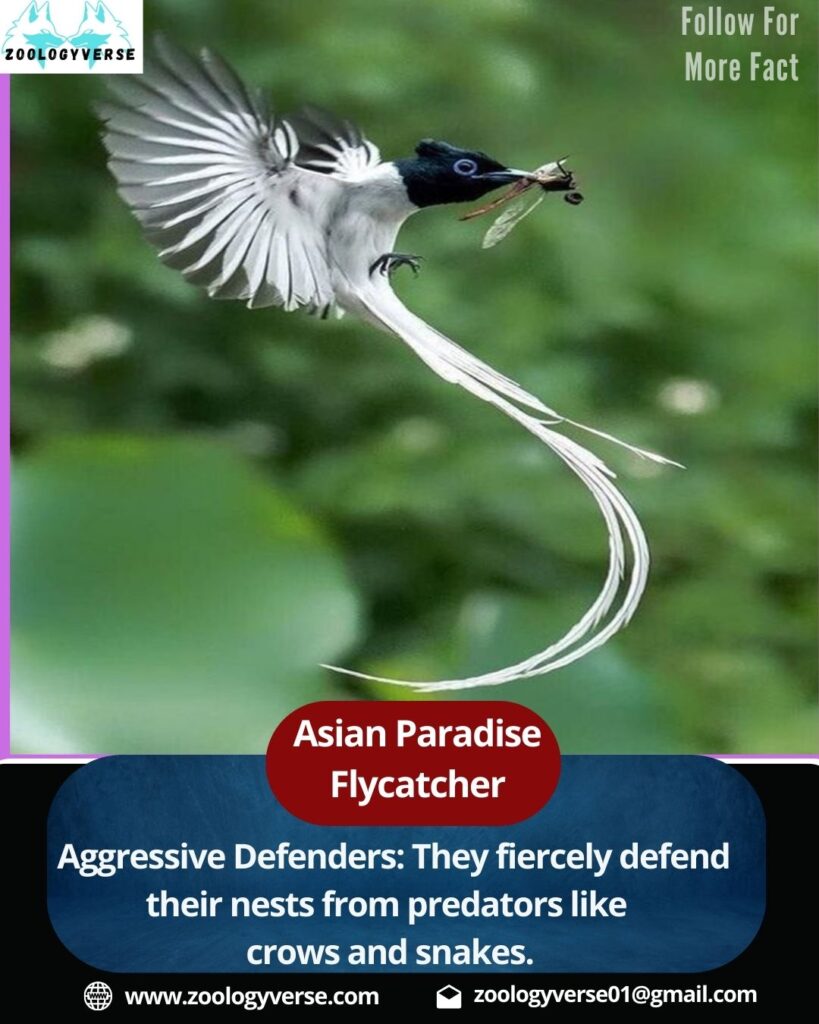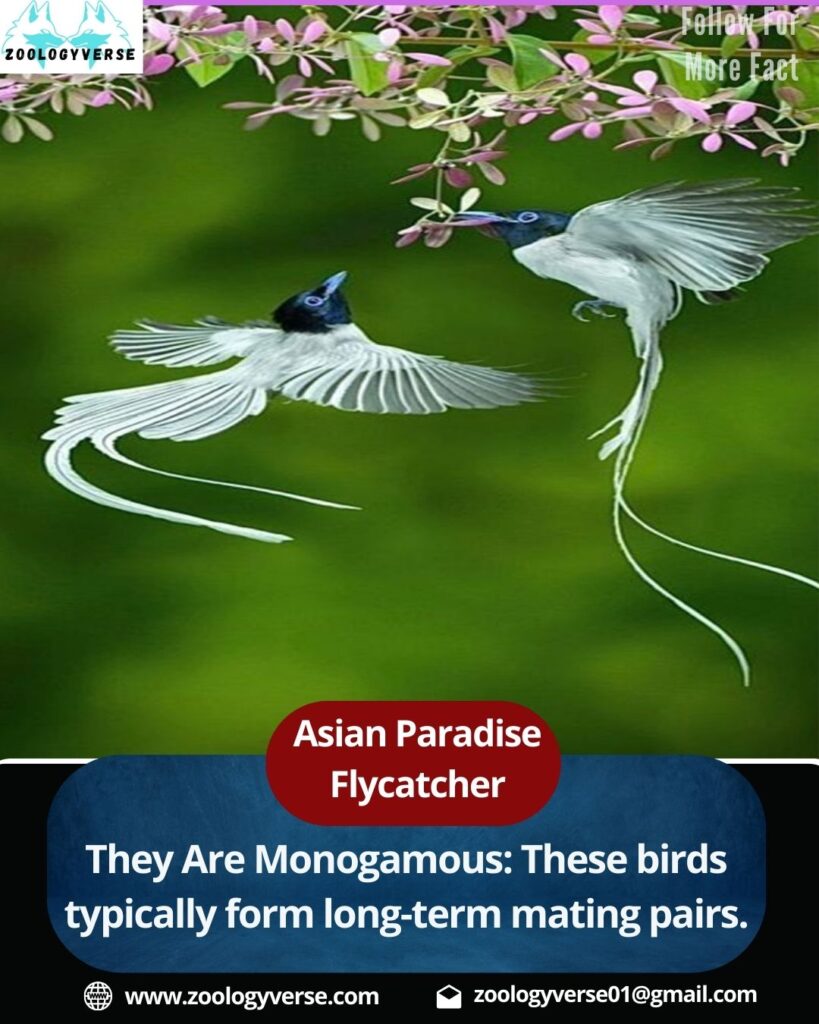Asian Paradise Flycatcher Overview
The Asian Paradise Flycatcher (Terpsiphone paradisi) is one of the most breathtaking birds found across Asia. Known for its striking long tail feathers and graceful movements, this bird has fascinated birdwatchers, photographers, and nature lovers for generations. With its distinct color variations, agile flight, and unique nesting behaviors, the Asian Paradise Flycatcher is a remarkable species that deserves admiration.
In this detailed guide, we will explore the habitat, behavior, diet, breeding habits, and interesting facts about this elegant bird. Additionally, we will address some frequently asked questions (FAQs) about the species.

Scientific Classification:
- Scientific Name: Terpsiphone paradisi
- Family: Monarchidae
- Order: Passeriformes
- Conservation Status: Least Concern (IUCN Red List)
Physical Appearance
The Asian Paradise Flycatcher exhibits an elegant appearance with its streamlined body, long tail, and sharp beak designed for catching insects mid-air.
- Males: The male Asian Paradise Flycatcher has two color morphs – white and rufous (chestnut). Both have a glossy black head with a distinctive crest. The most striking feature is the long ribbon-like tail feathers, which can be twice the length of the body.
- Females: They have a shorter tail, and their bodies are generally rufous or brownish in color with a duller black or grayish head.
The white-morph males are often considered the most spectacular, as their tail feathers create an illusion of a floating ribbon when they fly.
Habitat and Distribution
The Asian Paradise Flycatcher is widely distributed across South and Southeast Asia, extending into parts of China and the Indian subcontinent. Their preferred habitats include:
✔️ Tropical and subtropical forests
✔️ Riverine woodlands
✔️ Mangroves
✔️ Orchards and gardens
These birds are known to be migratory, traveling long distances based on seasonal changes and food availability. During the winter months, they migrate to southern regions, including Sri Lanka, Myanmar, and Indonesia.

Diet and Feeding Behavior
Asian Paradise Flycatchers are insectivorous, meaning their primary diet consists of insects and small arthropods. Their feeding habits are truly fascinating:
✔️ Aerial Hunting: They catch insects mid-air with great agility.
✔️ Hovering: They hover near leaves to snatch hidden prey.
✔️ Perch and Swoop: They wait on a perch and suddenly dart out to catch flying insects.
Their sharp eyesight and swift reflexes make them expert hunters in their natural environment.
Breeding and Nesting Habits
The breeding season of the Asian Paradise Flycatcher generally occurs between April and August, varying slightly based on location.
✔️ Courtship Displays: Males perform acrobatic flights and flutter their long tails to attract females.
✔️ Nest Building: The female builds a small cup-shaped nest using twigs, moss, and cobwebs, usually placed on tree branches.
✔️ Egg Laying: A female lays 2–4 eggs in a single breeding season.
✔️ Parental Care: Both parents share responsibilities in incubating the eggs and feeding the chicks.
Their strong parental instincts ensure the survival of their young in the wild.
10 Fascinating Facts About the Asian Paradise Flycatcher
1️⃣ They Change Colors Over Time: Males start as rufous-brown in their juvenile stage before transforming into their adult colors.
2️⃣ Males Have Long Tails, Females Don’t: The extravagant tail is a feature of adult males, while females have shorter, simpler tails.
3️⃣ They Are Monogamous: These birds typically form long-term mating pairs.
4️⃣ Masters of Camouflage: Their nesting sites blend well with their environment, protecting them from predators.

5️⃣ A Symbol of Beauty in Asian Culture: In many Asian cultures, this bird is associated with grace, elegance, and good luck.
6️⃣ Incredible Migrators: Some populations migrate over 2,000 kilometers during seasonal changes.
7️⃣ They Are Vocal Birds: They communicate using a variety of calls, including whistles and chirps.
8️⃣ Aggressive Defenders: They fiercely defend their nests from predators like crows and snakes.
9️⃣ Adaptable Birds: They thrive in both dense forests and urban gardens.
🔟 They Have Many Subspecies: There are multiple subspecies across Asia, each with slight variations in color and size.

Frequently Asked Questions (FAQs)
1. Where can I spot an Asian Paradise Flycatcher?
These birds can be found in India, China, Indonesia, Thailand, Myanmar, Sri Lanka, and many other Asian countries, especially in forests, gardens, and riverbanks.
2. How long do Asian Paradise Flycatchers live?
They have an average lifespan of 5–8 years in the wild, depending on environmental factors and predation risks.
3. Do both male and female birds have long tails?
No, only adult males develop long tail streamers. Females have a shorter tail.
4. What do Asian Paradise Flycatchers eat?
They primarily feed on insects, including beetles, flies, ants, and small moths.
5. Are Asian Paradise Flycatchers migratory?
Yes, some populations migrate to warmer regions during winter months, while others are resident birds.
6. Why do some Asian Paradise Flycatchers have white feathers and others have rufous feathers?
This difference is due to color morphs and genetic variations. Some males retain their juvenile rufous color, while others develop a white morph.
7. How do they catch insects?
They catch insects mid-air with incredible speed and accuracy.
8. What threats do Asian Paradise Flycatchers face?
Habitat loss, deforestation, and climate change are the biggest threats to their population.
9. Can these birds be kept as pets?
No, they are wild birds and should not be kept in captivity.
10. How can we help conserve Asian Paradise Flycatchers?
Conservation efforts include protecting forests, planting trees, and preventing illegal bird capture.

The Asian Paradise Flycatcher is a true marvel of nature, known for its graceful flight, stunning tail feathers, and expert hunting skills. Whether you’re a birdwatcher, photographer, or simply a nature lover, spotting one of these birds in the wild is an unforgettable experience.
By spreading awareness and protecting their habitats, we can ensure that future generations will continue to admire these incredible birds in the wild.
Want to learn more about birds and wildlife? Check out more articles on ZoologyVerse for fascinating insights into the animal kingdom!
Follow us on Facebook :- Click Here
